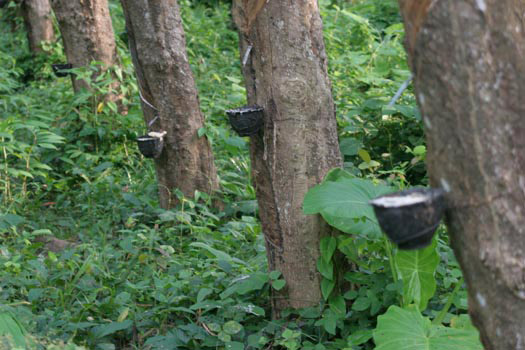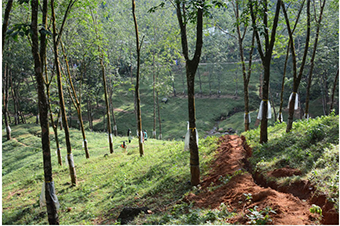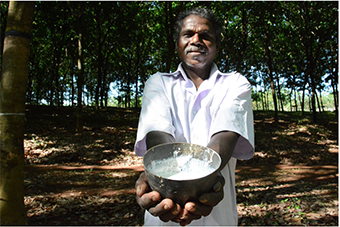Enter a web search for “natural rubber wellies” and dozens of products will pop up. But just how ‘natural’ is the rubber used in most wellingtons and rubber or gum boots and how sustainable is it? Many consumers will be surprised to learn that the natural tree rubber (latex) content can be as low as 15% of the overall polymer in rubber boots. And any brand claiming its rubber boots are “100% natural rubber” is not being fully transparent – i.e. it’s not telling you the full story – or perhaps they have been told that by their factory and have not thought to question it further.
Firstly, the rubber in any rubber boot or sole is actually a polymer – i.e. a combination of synthetic and natural rubber with fillers. Synthetic (butadiene) rubber is synthesizedfrom petroleum by product, while latex is a white milk tapped from hevea brasiliensistrees. There are also essential bulking agents, typically calcium carbonate (chalk), which are added to the polymer as well as lubricating oils, dyes and other substances for weather-proofing. The typical natural rubber percentage of a standard (low-end) rubber welly can be as low as 30% within the combined rubber content (that’s 15% within the total polymer). In other words not very "natural" at all.
At the high-end of the welly market – i.e. brands who are marketing their rain boots on the strength of their high natural rubber content – the maximum possible percentage of natural rubber is 75–80% of the total rubber content (or 90% for children’s boots because they don’t take as much wear and tear). There are only a handful of factories around the world who manufacture rubber boots with such a high percentage because the price of the boot will typically be a lot higher.
In our 10 years of experience we have found that it is not possible to make rubber wellingtons with 100% natural rubber. The liquid latex must be reinforced. In fact, the higher the synthetic content in the heel, the more abrasion the boot can withstand, which is why the polymer used for the outsole and heel needs to have a higher synthetic rubber content. The upper part of the boot can use a far higher percentage of natural tree rubber to make it more flexible where it fits around the ankle and cone of the foot.

Is “natural rubber” sustainable?
Natural does not necessarily mean sustainable or environmentally-friendly either. The price of natural rubber has been historically low for over ten years. Unfortunately, this has meant that in the last decade 7 million hectares of natural rainforest (an area the size of Scotland!) in countries like Cambodia, Laos and Vietnam have been cleared to produce rubber plantations, which are then managed in an unsustainable way, resulting in devastating loss of biodiversity. In fact in 2016, Global Witness called rubber "the new palm oil". It also means that rubber tappers have been forced to take lower wages and live in near poverty.
The sad fact is, the vast majority of factories making rubber products across the globe – and this includes many top and so-called “luxury” wellington brands – use standard, unaccredited, cheap latex rubber in barrels. This means they buy it from resellers who mix it from hundreds of different sources – in other words it is impossible to verify the provenance of that rubber.
But this is madness, because rubber trees are a carbon super-sink (they absorb up to x4 more carbon dioxide than indigenous forest) and should be part of the climate solution!

Consumer demand will drive change
This needs to change – but the demand for sustainable rubber needs to come from you, the consumer. If buyers don’t ask these questions, brands won’t bother to change their formulations or put pressure on their producers to lean on their suppliers to change. The rubber tyre industry (which accounts for 75% of all natural rubber consumed) is starting to transform itself. In 2019, they set up the GSPNR consortium in consultation with partners like the World Wildlife Fund to switch to sustainable sources, but they are a few years away from being fully sustainable. A handful of footwear brands are starting to change too. In 2020 Hunter launched their first sustainable rubber boot – a collaboration with Stella McCartney. In the USA and Canada there's Alice + Whittles who use Fair Rubber.
If you care about the fact your wellies are made with sustainably-sourced rubber, then only buy from brands who can guarantee their rubber is sustainably sourced – ideally their rubber suppliers will have the proper certification (e.g. PEFC, FSC and/or Fair Rubber), or equivalent certification.
Spats Boots – making sustainability the top priority
In 2020, Spats Boots joined the Fair Rubber association and is switching production to factories in Europe (2020/21) and Sri Lanka (2021/22) that can certify that their natural rubber is 100% sustainably sourced.


